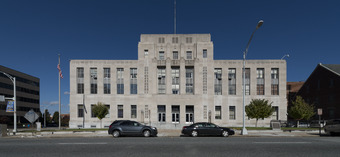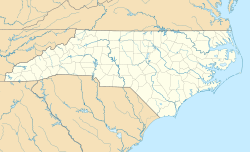L. Richardson Preyer Federal Building facts for kids
Quick facts for kids |
|
|
United States Post Office and Court House
|
|
 |
|
| Location | 324 W. Market St., Greensboro, North Carolina |
|---|---|
| Area | 1.4 acres (0.57 ha) |
| Built | 1933 |
| Built by | George H. Rommel Construction Co. |
| Architect | Murphy and Olmstead; Office of the Supervising Architect under James A. Wetmore |
| Architectural style | Art Deco |
| NRHP reference No. | 14000886 |
| Added to NRHP | October 29, 2014 |
The L. Richardson Preyer Federal Building is a courthouse in Greensboro, Guilford County, North Carolina. It is where important legal cases for the U.S. government are heard. This building was finished in 1933.
In 1988, it was renamed to honor L. Richardson Preyer. He was a U.S. Representative and a judge. The building is located at 324 West Market Street. In 2014, it was added to the National Register of Historic Places. This is a special list of buildings, sites, and objects that are important to American history.
Contents
Why This Building Matters
A New Building for Greensboro
The Preyer Building was built because of a law called the Public Buildings Act of 1926. This law helped fund new government buildings. The design was created by Murphy and Olmstead, an architecture firm from Washington. James A. Wetmore's office helped supervise the work. The George H. Rommel Construction Company built the building.
Greensboro really needed a new building. It was planned to be a post office, a courthouse, and a general federal building. Construction started in December 1931. When the building was officially opened on July 6, 1933, over 5,000 people came to the ceremony!
From Post Office to Courthouse
For many years, the building served as a post office. But in the late 1980s, the postal service moved out. After that, the first floor was changed. It became more courtrooms and offices for legal work. Today, the building is mostly used as a courthouse for the Middle District of North Carolina.
A Historic Location
The spot where the building stands is also important. Before this federal building, a house called the Sloan House was there for 100 years. This house was said to be made from wood from the first Guilford County Courthouse. People even say that armies fought near this house during the American Revolutionary War. Later, it was home to Greensboro's first mayor. The building is now near the city's downtown area. It is also right across from the Guilford County Government complex.
Building Style and Design
Art Deco Architecture
The courthouse is built in the Art Deco style. This style was popular in the 1920s and 1930s. It often features bold geometric shapes and rich decoration. The main entrance faces south. There are other entrances on the north and west sides. The building is about 202 feet 8 inches (61.77 m) long on the west and east sides. It is about 150 feet 4 inches (45.82 m) long on the north and south sides.
Today, the south entrance is the main one. The west entrance is closed. The north entrance, which is at the basement level, is used sometimes.
Outside the Building
The Federal Building is four stories tall. It also has a basement that is fully used and an empty attic. The bottom part of the building is made of Mount Airy granite. The walls above are covered in Indiana limestone. The decorations are also made of limestone.
The south side, which is the main side, has fifteen sections called bays. The five central bays stick out a bit. This is where the main entrance is. The entrance area has three doors on the first floor. It also has parts that step back on the third and attic levels. You can see carved decorations with a lotus flower design. The windows on the second and third floors are set back slightly. They are in pairs and separated by aluminum panels with a diamond pattern.
Main Entrance Details
Steps made of granite and terraces of Crab Orchard stone lead to the main entrance. The three-bay entrance sticks out a little from the rest of the building. On either side of the doors, there are carved stone grilles. The second and third floors have four tall, grooved columns. These columns have carved tops with lotus flowers and scroll designs. Between the columns are carved panels with lotus flowers and plain shields.
Between the second and third-floor windows, there are aluminum panels. These panels show the seals of different U.S. government departments. These include the Treasury Department, the Post Office Department, the Department of Justice, the War Department, the Department of Agriculture, and the Department of Labor. On the fourth floor of the entrance area, there is a three-bay section that steps back. It has triangular columns on the sides. Between the windows are columns with carved eagles' heads on top of Federal shields.
Other Sides of the Building
The west side of the building shows its U-shape. You can see the basement windows on this side. The decorations here are similar to the south side. There is a decorative band above the third floor. The replacement double aluminum doors have a polished granite frame. It has round decorations and a fancy top part called a pediment. This pediment has a lotus flower and heavy floral carvings. There are also open, geometric granite grilles next to the door.
The north side of the building has similar decorations to the south side. However, its central entrance area has only one door. This door is reached by two sets of granite stairs. At the basement level, there are recessed doors leading to the north basement lobby. The polished granite around this door is the same as on the west side. The stone light posts on each side are slightly different.
Inside the Building
Inside, some important areas are still in great condition. The courtroom on the third floor looks almost original. It has marble walls and original doors and furniture. The south lobby changed a lot when the postal service moved out. Many of the old mailboxes and windows were removed. However, the entry foyer is still a key feature. It has a fancy ceiling, marble walls, and original light fixtures. The hallways on the second and third floors also add to the building's character. They have original floors and door frames.



